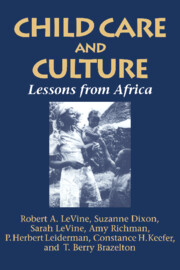Book contents
- Frontmatter
- Contents
- List of tables and figures
- Foreword
- Acknowledgments
- Introduction
- Part I African infancy: Frameworks for understanding
- Part II Parenthood among the Gusii of Kenya
- 3 Gusii culture: A person-centered perspective
- 4 Gusii fertility, marriage, and family
- 5 Pregnancy and birth
- Part III Infant care and development in a Gusii community
- Part IV Interpretations
- Appendix A Fieldwork procedures: Initial phases and planning
- Appendix B Coding categories for spot observations
- Appendix C Blankhart Nutrition Questionnaire
- Appendix D Temperament Assessment Method
- Appendix E Coding categories for narrative observations
- Appendix F Coding categories for face-to-face interaction
- Appendix G Coding categories for maternal teaching task
- Appendix H Supplementary tables
- Notes
- References
- Index
- Plate section
3 - Gusii culture: A person-centered perspective
from Part II - Parenthood among the Gusii of Kenya
Published online by Cambridge University Press: 11 May 2010
- Frontmatter
- Contents
- List of tables and figures
- Foreword
- Acknowledgments
- Introduction
- Part I African infancy: Frameworks for understanding
- Part II Parenthood among the Gusii of Kenya
- 3 Gusii culture: A person-centered perspective
- 4 Gusii fertility, marriage, and family
- 5 Pregnancy and birth
- Part III Infant care and development in a Gusii community
- Part IV Interpretations
- Appendix A Fieldwork procedures: Initial phases and planning
- Appendix B Coding categories for spot observations
- Appendix C Blankhart Nutrition Questionnaire
- Appendix D Temperament Assessment Method
- Appendix E Coding categories for narrative observations
- Appendix F Coding categories for face-to-face interaction
- Appendix G Coding categories for maternal teaching task
- Appendix H Supplementary tables
- Notes
- References
- Index
- Plate section
Summary
The Gusii people, now numbering over a million, inhabit the southwestern corner of the Kenya highlands, elevated above the hot coast of Lake Victoria farther to the west (Figure 3.1). They have occupied this territory – with its cool climate, rich soil, and abundant rainfall – for perhaps two centuries, maintaining a distinctive Bantu language and ethnic identity amidst the Nilotic speaking peoples who surround them. Geographically isolated in 20th-century Kenya, the Gusii nevertheless have become known throughout the country since World War II, first for their productive agriculture, and more recently for their exceptionally high fertility and population growth.
The Gusii were precipitously introduced to Western culture in the first decade of the 20th century when they came under British rule and the first Christian missionaries arrived. Their lives have never been the same, and the pace of social change has increased with each successive decade up to the present. Yet their contemporary survival strategies, family life, and patterns of child care can only be understood in terms of traditions inherited from their ancestors. Here we present an overview of Gusii culture and institutions in precolonial times and how they changed between 1907 and 1974, of the Gusii life course as experienced by adults and learned by children, and of the community in which we studied Gusii young children and their parents from 1974 to 1976.
- Type
- Chapter
- Information
- Child Care and CultureLessons from Africa, pp. 57 - 91Publisher: Cambridge University PressPrint publication year: 1994



